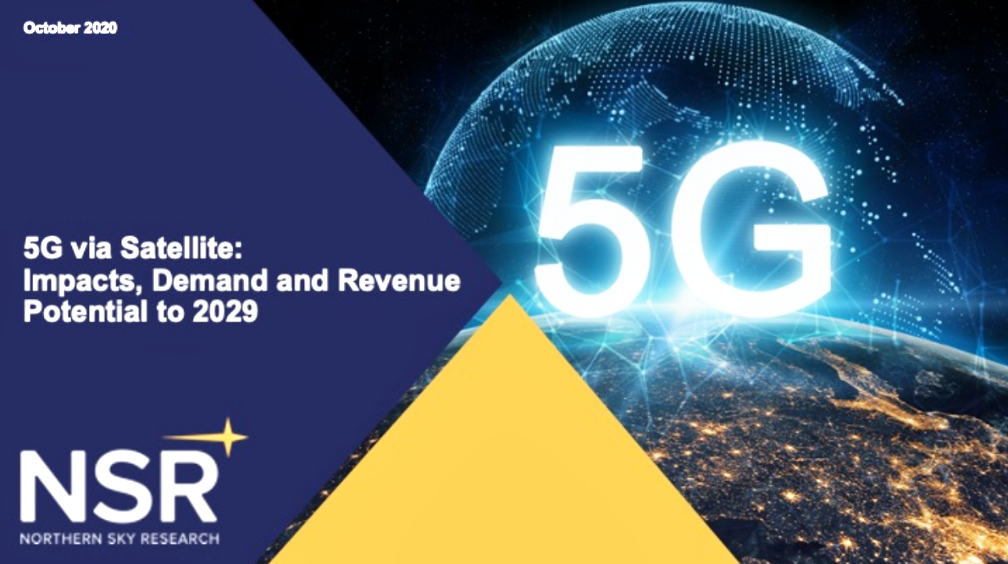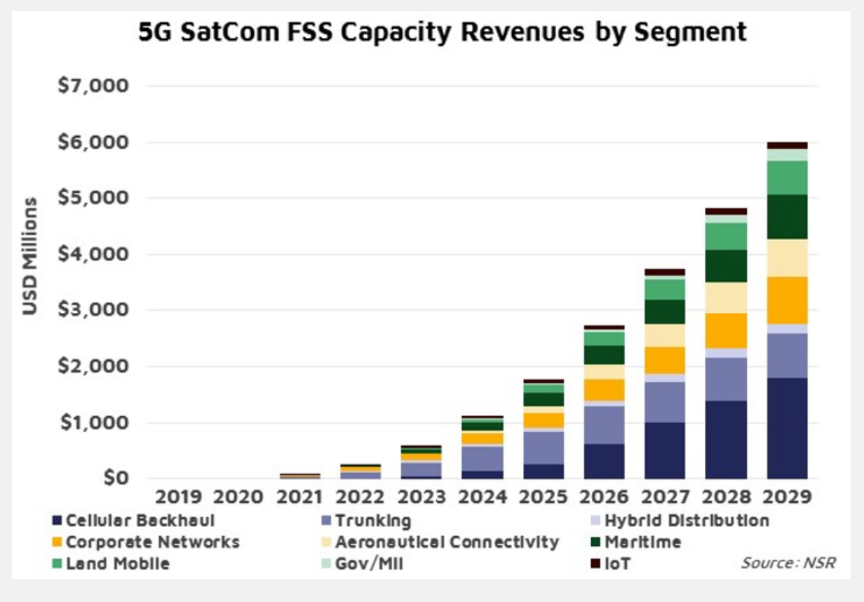Article by Lluc Palerm, NSR Senior Analyst, Spain

Previous ‘Gs’ of mobile communications were very narrow, primarily focusing on consumers and operating independently from the rest of communications technologies. But the vision of 5G is much wider unlocking uncountable enterprise-oriented use cases and offering a framework for integrating all other communications technologies. In this sense, 5G will be transformational in many aspects of the Satcom ecosystem: from stimulating demand in many segments, seamlessly integrating Satcom in the mainstream Telco ecosystem or becoming a tool for optimizing Satellite Network design and operations.

In fact, the waves of 5G will resonate across the entire value chain with new business models and opportunities leveraging virtualization, standardized service orchestration or 5G NR. The good news is that potential for revenue growth is extraordinary. NSR forecasts in its 5G via Satellite: Impacts, Demand and Revenue Potential report that 5G will generate $21 Billion in 2019-2029 cumulative FSS Capacity Revenue.
What is 5G?
Simply put, 5G is the new set of standards for cellular networks. But one can depict 5G as 2 things:
5G NR, a new set of radio access standards (how terminals communicate with Base Stations) 5G Core, a standardized framework for Network Management and service orchestration
What makes 5G so relevant for Satcom is that 5G has the vision to become a ‘Network of Networks’, allowing non-3GPP technologies (including satellite) to be seamlessly integrated in the 5G core. Furthermore, 5G NR (access network) is defined in a way that allows end-user terminals to directly communicate with Non-Terrestrial Base Stations.

Five years from now, when measuring the success of Satcom in the transition to 5G, Satellite should no longer be a separate or siloed ecosystem, becoming a transparent solution tightly integrated with mainstream deployments. Quantitatively, this translates into much higher adoption of SATCOM services.
A Catalyzer for Growth
5G will change the perception of what is defined as ‘Broadband’, boosting bandwidth demand in all segments (even non-5G use cases like Consumer Broadband). Naturally, Cellular Backhaul and Trunking will be among the fastest-growing segments for 5G, leveraging easier integration. Furthermore, regulators are tying strict coverage obligations with new spectrum releases for 5G to avoid a second digital divide. France and South Africa are recent examples showing that the trend repeats in both developed and emerging markets.
A big effort from MNOs to monetize 5G is going towards Enterprise-grade services. Consequently, it is not a big surprise that Private 5G for Corporate Networks (Mining, Oil & Gas) and Maritime (Merchant shipping) will be among the early adopters for Satcom 5G services.
The IoT and handheld segments are worth special mentions. While 5G NR (access technology) might not be able to support the high throughput use cases, Satellite IoT and low data-rate use cases will be able to directly implement 5G NR in their networks. This is a game changer, opening a vast addressable market counted in Billions of devices. Leveraging mainstream chipsets and devices, terminal costs will decrease dramatically, and sales channels will instantly become global and ubiquitous.
Transforming How Networks are Architected
Easily left under the radar, but one of the areas with the largest impact for Satcom is ‘5G Core.’ 5G will emerge as a transversal network management system, controlling not only 3GPP-defined access technologies, but also non-3GPP access methods like the ones specific to Satcom. The Telco world often disregards Satellite due to specific know-how and complexities in integrating it. With standardized service orchestration based on 5G, Satellite becomes plug-and-play for mainstream Communications Service Providers.
Not only that but incorporating 5G into Satellite Network architectures will also optimize network operations. 5G incorporates the latest developments in SDN/NFV, Cloud, Virtualization, etc. Satellite does not need to reinvent the wheel and can adopt 5G network management systems to optimize operations of VHTS, constellations, software-defined satellites and hybrid networks. Bottom Line
5G is much more than just the next ‘G’ with the ambition to be a transversal ecosystem grouping diverse access technologies, including Satellite. This is transformational for Satcom as it opens the opportunity to become mainstream, with much higher adoption rates.
The opportunities unlocked by 5G span across a wide array of use cases. Beyond Backhaul and Trunking, which naturally capture solid growth, 5G will stimulate demand in segments like Corporate Networks and Mobility, among others. With 5G NR being modified to offer direct connectivity from end-user mainstream devices to Non-Terrestrial Networks, Satellite IoT and handheld devices will experience a vast boost in the addressable market.
Beyond its customer-facing impacts, 5G will have a huge impact on how networks are designed and operated. Adopting ‘5G core’ as the Network Management system will allow Satcom to seamlessly integrate with the mainstream Telco ecosystem, but it would also be a tool to optimally operate next generation satellite networks (VHTS, flexible satellites, constellations, etc.).
